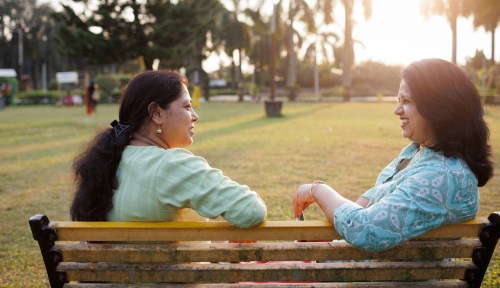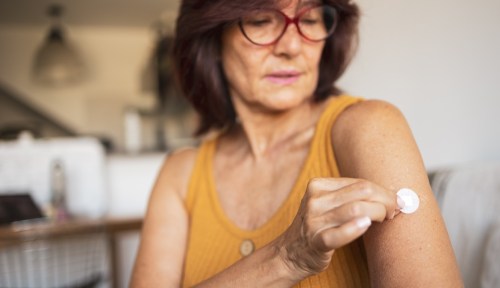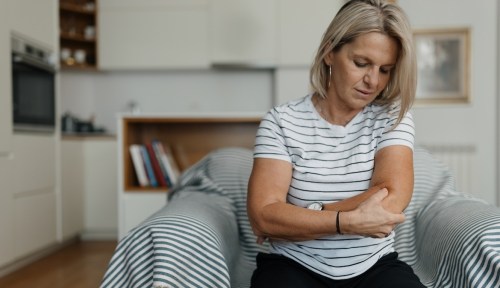Black People Spend 10 Years in Menopause, on Average, Compared To 7 for White—But They’re Less Likely To Receive Care
A Black OB/GYN and researcher explains why Black people experience poorer health outcomes during menopause and what can be done to help.

In our work as clinicians and researchers, we’ve made big strides in the past decade toward better understanding menopause. For starters, we used to think menopause was short-lived. Even the most extreme hot flashes and night sweats were thought to last just about two years—a finite-enough period, perhaps, to support common attitudes around suffering in silence. But research from 2015 confirmed that, as many people have long experienced firsthand, this biological phase often lasts much longer: seven years, on average, and as many as 14. What we’re still only beginning to grasp are the many variations within those years—namely, who suffers the most, and for the longest, and why. As with most other elements of health, race has proven to be a significant factor, with Black people experiencing lengthier transitions into menopause, more severe symptoms, and poorer health outcomes.
These were the conclusions of a recent literature review I co-conducted on the racial disparities in menopause. My five co-authors and I reviewed 100-plus published studies covering menopausal outcomes (like age at menopause onset, hormone levels, sleep symptoms, and more) in order to get a full picture of cultural differences. What we found is that not only were menopause symptoms in Black people more severe and longer-lasting, but also, Black people were less likely to see a medical provider for menopause symptoms, and if they did, they were less likely to be prescribed treatment.
Black people experience lengthier transitions into menopause, more severe symptoms, and poorer health outcomes.
These findings build on the outcomes of the Study of Women’s Health Across the Nation (SWAN), which is the biggest dataset we have on the menopause process. This research project began screening women in 1996, enrolling more than 3,000 (about 28 percent of whom are Black) who took part in surveys and medical visits over 25 years. Using this data, researchers conducting the 2015 study above determined that Black women experience menopausal symptoms for, on average, 10 years (whereas that number is 6.5 for white women and 8.9 for Hispanic). And in 2022, a review focused on identifying racial disparities in the SWAN dataset found that Black women start menopause, on average, 8.5 months earlier than white women, have worse hot flashes and night sweats, are more likely to experience depression, and have worse sleep quality.
Looking at the underlying context for these results tells a bigger story of disparity, however. As the 2022 review found, it’s also true that Black people are, on average, less educated than white people, more likely to smoke, and less financially secure—all outcomes linked to the social determinants of health and associated with entering menopause at an earlier age.
In fact, when the researchers conducting the review controlled for these factors, the difference in age of menopause onset between Black and white women went away. This suggests that the reason Black folks have a worse menopausal experience isn’t tied to an inherent racial difference so much as it is to racism—and a complex mix of sociodemographic, health-related, and cultural factors linked with it.
Why Black people experience worse menopausal outcomes
Racial differences in menopause symptoms and care are the latest indication of racial health disparities, which are something I’ve been immersed in since the beginning of my medical career in the ’80s.
Starting in medical school, I encountered disparities in my research work on atherosclerotic diseases. Then, when I completed my OB/GYN internship and residency at a military hospital, I noticed clear differences in how Black enlisted people were treated versus white. For example, I found that many Black patients, despite having significant injuries or illnesses, had challenges with getting profiles (the term for a document issued by a military doctor to tell an enlisted person’s supervisor what they can safely do with a particular health condition or pregnancy).
The common theme was that Black patients, especially Black women, were ignored or dismissed without receiving adequate care or information.
During my fellowship training for reproductive endocrinology and infertility, I became more aware of the need to understand racial disparities, not just in the patient-doctor experience but in clinical outcomes, too. At the time, in the mid-’90s, we weren’t effectively gathering racial and ethnic demographics in our work with in vitro fertilization (IVF), which I realized also meant that we wouldn’t be able to really look at those differences. So, I struck up a conversation with my division director. He just looked at me and said, “You’re the one who brought it up. Why don’t you do something about it?”
Not long after, in 2004, I founded the health disparities special interest group for the American Society of Reproductive Medicine (ASRM). It’s through the work we’ve done since that I’ve come to better understand why we see so many racial disparities in health care and health outcomes, and what we need to do to reverse course.
When it comes to menopause, specifically, plenty of the same factors that influence the health of Black people can, in turn, affect our menopausal experience. As noted above, Black people are disproportionately impacted by the social determinants of health (which refer to things like socioeconomic status, employment, and access to health care). This makes it more likely that a Black person will enter menopause with a preexisting health condition, like diabetes or hypertension, which can worsen menopause symptoms.
Similarly, the systemic racism that diminishes outcomes for Black women with health conditions can also affect how they’re treated for menopause—if they even make it into a doctor’s office. A curious finding from our research was that, while objective markers of menopause symptoms were worse in Black people versus white, overall, Black people reported higher quality-of-life indicators. Which is to say, Black people didn’t seem to be as disturbed by what we know to be significant symptoms, like sleep loss and hot flashes. What we presume is that these women were minimizing how they really felt. And once you’re downplaying your symptoms to yourself, you’re far less likely to seek medical treatment.
Closely tied with that outcome is another one of our findings: that Black people tend to get information about menopause from trusted friends and family members, whereas white people get it mostly from medical providers. Based on intel from focus groups, it’s likely that the social circles where Black people source information perpetuate the “I’ll get through this myself” narrative—again, leading them to not seek out the care of a doctor.
There’s this sense among many [Black people] that the medical community just doesn’t really care about us, that we’re not listened to, or that we’re minimized.
Underscoring these scenarios is the well-warranted mistrust that many Black people have for the medical system, given its history of misusing and abusing Black bodies. In reviewing studies that explored the lived experience of Black people in menopause, my coauthors and I found that there’s this sense among many that the medical community just doesn’t really care about us, that we’re not listened to, or that we’re minimized.
Studies in our review also showed that clinicians are less likely to prescribe hormone therapy to Black people in menopause than white, despite no medical basis for the distinction. What we’re still working to understand is the why. Are the treatment numbers so low among Black people, in fact, because doctors underestimate the severity of their symptoms? How often are Black people offered treatment, and how often do they accept it? There’s a lot of nuance, and we need more research to flesh out some of these differences.
What can be done to reduce the disproportionately high burden of menopause on Black people
There are two sides to the solution: the provider side and the patient side. We know that, on the provider side, unconscious bias plays a role in how we provide information and care. For just one example, it’s part of the reason Black people are routinely provided with less pain management for the same conditions than white people. And in the case of menopause, which many OB/GYNs aren’t even educated to treat, a lack of information may only fuel that bias further. So, what we’re working to do is raise the level of awareness in providers that they need to actually listen to their patients.
As providers, we often pre-assess patients and pass judgment about what they will or won’t be receptive to in terms of treatment, what they can and can’t afford, what their compliance might be. And some of these shortcuts are necessary, given the short timeframe of a typical appointment. But, that just underscores the necessity for training on unconscious bias so that providers with little time on their hands can swiftly identify it when it happens. Right now, my team and I are working on training modules that we’ll encourage the American Board of Obstetrics and Gynecology (ABOG) to mandate as part of our re-credentialing process.
There are cultural differences in the ways that we show up as people and the ways we communicate and interpret information.
The biggest takeaway I’m hoping providers can glean from bias training is cultural humility. There are cultural differences in the ways that we show up as people and the ways we communicate and interpret information. It’s important for doctors to understand that and to recognize that they don’t know all the details of a patient’s lived experience from before they walked into their office. Simply acknowledging that reality can improve the way they provide care to Black people.
On the patient side, I urge everyone to look for credible sources of education on menopause, like those provided by the North American Menopause Society (NAMS), which also has a list of certified menopause providers. Given, again, the lack of providers with knowledge about menopause, it’s important for patients to prioritize seeing a provider who is NAMS-certified (if there’s one in their area) to increase their chances for quality care.
Before you head into a visit, be sure to write down all of your questions. This way, you’re not waiting until the doctor asks and their hand is practically on the door to leave; at the beginning of the visit, you can say, “These are the things I really need to address with you.” And if you’ve researched treatments in advance, you can also say, “Please help me walk through these options. What do I need to consider based on my health status?” Because visits are so short and so truncated, the more you can do that, the better you’ll fare.
I also suggest bringing an advocate with you to a visit versus going alone, which can help shift the power dynamic. This person can just be a friend or family member who understands what you’re going through and can support you in making sure that you ask the questions and get the answers that you need.
And if you still have questions at the end of a visit? Ask for additional resources or information and suggest a follow-up to discuss further. Managing menopause often can’t happen within the window of a 15-minute conversation, so as much as you can avail yourself for a future visit, in-person or virtual, you’ll stand to benefit.
As told to Erica Sloan.
This story is a part of Black [Well] Being, examining the state of Black health and well-being in the U.S.—and those working to change outcomes for the better. Click here to read more.
Sign Up for Our Daily Newsletter
Get all the latest in wellness, trends, food, fitness, beauty, and more delivered right to your inbox.
Got it, you've been added to our email list.










